The United Nations declared 2016 the International Year of Pulses. What’s a pulse? It’s the dry mature seed of a large number of species in the legume family (Fabaceae): various beans, peas, soybean, chickpeas, lentils, peanuts and other groundnuts. 2016 is days from ending, so it’s high time I get up the Fabaceae diversity post I’ve been meaning to write all year long. This rounds out our year of legume coverage, which included Katherine’s posts on bean anatomy, peanuts, and green beans.

Christmas Lima beans (Phaseolus lunatus), soaking before cooking
One out of every 15 flowering plant (angiosperm) species is a legume, a member of the large plant family Fabaceae (Christenhusz and Byng 2016, LPWG 2013). Boasting around 19,500 species in 750-ish genera (LPWG 2013), the Fabaceae is the third-largest plant family in the world, trailing behind only the orchid (Orchidaceae: 27,800 species) and aster (Asteraceae: 25,040 species) families (Stevens 2016). By my count, people only use about 1% of legume species for food (my list of edible legume species is found here), but that small fraction of species is mighty. People eat and grow legumes because they are nutritional superstars, can be found in almost all terrestrial ecosystems around the world, and uniquely contribute to soil fertility in both wild and agricultural ecosystems.
A finger on the pulse of edible legume diversity
One out of every 20 grams of protein consumed by people across the planet is from pulses, the protein-rich mature (usually dried) seeds of several legume species: various beans, peas, lentils, soy, peanuts and other groundnuts (Heine 2016). In some regions, however, especially in the developing world and in cultures that do not consume animal protein, the contribution of pulses to dietary protein is considerably higher than that 5% global average (Heine 2016). Protein comprises 20-40% of pulse seed mass, compared to 7-15% of seed mass of grains from the grass family (Poaceae; see our takes on them here and here), which are responsible for most of the calories consumed around the world, mostly in the form of rice, wheat, and corn (Vitale and Bollini 1995).

Black-eyed peas, in a pot, a traditional New Year’s Day pulse. Make some Hoppin’ John!
Highlighting the importance of pulses to global diets is the main reason why the United Nations declared 2016 the International Year of Pulses (Their website has a really good pulse recipe section to which you can submit. Last year was the International Year of Quinoa; read Katherine’s excellent essay about quinoa and its relatives here). There is a lot more to legume food than just pulses, so I’ll provide an overview of legume food before diving into how it is that legumes are nutritionally and agriculturally important (they do nitrogen fixation), which happen to be the same ultimate cause of why we only eat 1% of legume species (they use their nitrogen to make poison as well as protein). Finally I’ll do my best to elucidate the evolutionary pattern (phylogeny) of edible legume diversity.
Root to Shoot: Legume structural diversity in the cornucopia
While pulses—mature seeds—are nutritionally the most important legume food items we eat from a calorie and protein standpoint, they are far from the only plant structures we eat from the Fabaceae (see structures consumed in my list of edible legumes).

A fresh fava bean (Vicia faba), torn crosswise during shelling. Spongy pith (endocarp) protects the immature seeds.
The fruit of all legume species is a pod, a simple single chamber (carpel) with two seams, containing one to several seeds. The pod is called a legume, hence the family nickname. We eat all or part of the pod from several species in a few different ways.

tTamarind (Tamarindus indica) pods in a Cambodian market (photo by L. M. Osnas)
Some legume species produce sweet or otherwise flavorful pulpy tissue in their pods that is eaten by itself without the seed (ice cream bean, tamarind, honey locust, huamúchil), or dried and ground into a flour with the seeds (mesquite, carob).
And as Katherine recently described, green beans (or French beans, string beans, snap beans, wax beans) are the immature fruits (pods) of several bean species, mostly: common bean (Phaseolus vulgaris), runner bean (Phaseolus coccineus), yardlong bean (Vigna unguiculata sesquipedalis), hyacinth bean (Lablab purpureus), and sword bean (Canavalia gladiata).

These Kentucky wonder beans (Phaseolus vulgaris) are a bit too mature to pick as a green bean; they were excellent left to ripen into a pulse, however.
Some varieties have a “string,” the hard fibrous strand running the length of the pod on one or both seams that can be removed before cooking (botanically the string is a lignified—woody—sclerenchyma cap outside the phloem of the vascular bundle running along one or both sutures of the fruit).
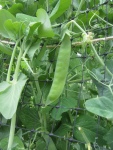
snap pea
Similarly, we eat the fresh, immature pod of some garden pea (Pisum sativum) varieties as snow peas or snap peas. With several varieties of both beans and peas, we can eat the immature seeds and pods when they are young and tender, or we can wait until the seeds mature and the pods dry, turning them from a vegetable into a pulse. This is a boon for gardeners who might not be completely diligent in harvesting all their green beans when young and tender. Also in the vegetable vein, young shoots and leaves of many legume species are eaten raw. Pea shoots are especially popular. A few species are eaten as sprouts, including alfalfa and mung bean.
Jicama is probably the most famous and widespread of several perennial legume herb or vine species that produce edible starchy root tubers that can be eaten raw or cooked. Well, in the southern United States, that honor probably goes to the ubiquitous invasive kudzu vine (eat that weed!), not jicama.

Caracalla bean flowers
The flowers of many species are edible, including the striking and fragrant flowers of the caracalla bean, which Thomas Jefferson grew at Monticello and described as “the most beautiful bean in the world.”
Rooibos (“red tea”) and honeybush are dried leaves/shoots from two South African legume shrubs used as herbal infusions (“tea”). Dried alfalfa leaf and red clover flowers are also used as tea.
Some pulses are multi-purpose. Peanuts and soy are pulses when consumed as whole seeds, but the seeds are also pressed for cooking oil. The nuña, a variety of the common bean, is a unique popping bean. When cooked dry over high heat, the nuña’s starchy cotyledons explosively puff up, like popcorn (although in popcorn the starchy puffing structure is endosperm, not cotyledon).
Some legume seeds are culinary spices (fenugreek, wattle) but might also be cooked in quantity like a pulse.
Polysaccharide compounds from some legume seeds (guar, cassia, tara, locust bean gum from carob) or resin (gum Arabic) or sap (gum tragacanth) are used as culinary gums and binders. The sticky-sweet root extract from the licorice plant is boiled to make the iconic candy.

mesquite (Prosopis spp.) pod flour
Note that there are several plant foods that are not legumes whose common names nonetheless include “bean,” for example: coffee bean (Coffea; family Rubicaceae); cocoa bean (Theobroma; Malvaceae); vanilla bean (Vanilla; Orchidaceae); castor bean (Ricinus; Euphorbiaceae); and sea bean (Salicornia; Amaranthaceae).

legume shrubs and trees in the Sonoran Desert, including mesquite
The diversity of legume food plants reflects the fantastic morphological and life history variation in the family. In their 64 million years of existence, legumes have come to occupy most terrestrial ecosystems on Earth and exist in every botanical size and life history category: annual herbs and vines, perennial herbs and vines, shrubs, lianas (woody vines), and temperate and tropical trees (LPWG 2013, Stevens 2016). These life forms appear to be somewhat evolutionarily labile, waxing and waning into one another on what we currently understand to be the legume phylogeny (discussed below). We get food from all the different legume lifeforms and from many different branches of the legume family tree. One characteristic this motley set of edible legumes does share, though, is nitrogen fixation, which I will expound on a bit before we talk about legume phylogeny and domestication.
Prodigal sons of the plant world: Nitrogen fixation in legumes

Peanuts (Arachis spp.) are pulses that store seed resources primarily as protein and fat (photo by K. Preston).
Across all plants in the world, there is little rhyme or reason, as far as we’ve been able to figure out, as to why certain plants store their seed’s resources as protein, fat, or carbohydrates (Hanson 2015). Legumes store seed resources in all three forms. We get industrial quantities of both oil and protein from soy beans and peanuts, for example. My husband considers pulses to be the “starchy” side dishes to accompany meat instead of the respectable protein source much of the mostly vegetarian world recognizes them to be.

Lentils (Lens spp.) are pulses that store seed resources mainly as protein and carbohydrate
Within the legumes, though, part of the protein-versus-carbohydrate seed storage form seems dictated by environment and where the seed stores its resources. The most carbohydrate-leaning seeds are those of species that live in dry and drought-prone environments and store their seed resources in endosperm, like many other non-legume seeds including grains (see Katherine’s description here), instead of in enlarged cotyledons, which is the strategy favored by most legumes, including all culinary beans and peas (see Katherine’s bean posts here and here for the details). Some carbohydrates in those “endospermic” legume seeds (including alfalfa, fenugreek, carob, and guar) are highly branched complex polysaccharides that have high affinity for binding water for seed germination in places where water can be scarce. It turns out those complex water-binding carbohydrates make excellent emulsifiers, thickeners and binders for humans’ food and industrial products. We extract polysaccharide gums from many different legume species, and they show up in diverse products spanning the cultural gamut, from vegan ice cream to fracking fluid (Hanson 2015).
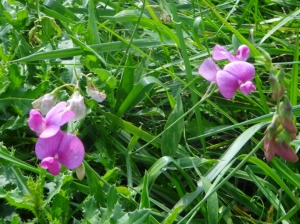
weedy wild Lathyrus latifolius: inedible but a good nitrogen fixer, contributing nitrogen to this meadow
Legume seeds are exceptionally good sources of protein because they can afford to throw around large quantities of nitrogen, an essential plant nutrient that is scare (limiting to plant growth) in most terrestrial ecosystems. Legumes are able to profligately live what my college ecosystem science professor called a “nitrogen-rich lifestyle” because they have their own little nitrogen fertilizer factories in their roots, full of specialized symbiotic bacteria (Rhizobium spp.) that perform nitrogen fixation. The bacteria, housed in specialized root nodules and fed a steady diet of sugar derived from the plant’s photosynthesis, with the aid of the plant, ultimately transform unusable nitrogen gas (N2) from the atmosphere into biologically available nitrogen compounds: ammonium (NH4+), nitrate (NO3–), or amino acids. The legume plant uses that nitrogen to build its own tissues (nitrogen is a main ingredient in proteins and DNA) and to imbue its seeds with large concentrations of specialized protein used for energy, defense, and amino acids.

scarlet runner bean (Phaseolus coccineus)
After a legume plant discards structures or dies, the substantial nitrogen in its tissues becomes part of the soil and available to other plants that do not form nitrogen-fixation symbioses, which is most plants. Legumes thereby uniquely contribute to soil fertility in both wild and agricultural ecosystems. That is why legumes are popular as cover crops and in crop rotations, naturally improving the soil for the next crop and reducing the need for artificial nitrogen fertilizer. This food security and agricultural sustainability benefit of legume crops is the other beneficial aspect of pulses that the UN wanted to highlight in this International Year of Pulses.
Pairing grass family (Poaceae) grains and legume pulse crops for both the nutritional (complementary amino acids, both needed for human protein synthesis) and agricultural benefits is likely a very early feature of agriculture and independently emerged multiple times: in the Fertile Crescent and Europe, wheat, oats, rye, and barley were paired with chickpeas, lentils, fava/broad beans, grass peas, fenugreek, and garden/split peas; rice was paired with soy, azuki and mung beans in China; in the Americas the “three sisters” were squash, corn, and beans (common beans, Lima/butter beans, peanuts, lupines); cowpeas and Bambara groundnuts grew alongside sorghum and millet in Africa (Hanson 2015, Vaughan and Geissler 2009).

Two of the “Three Sisters”: bean (Phaseolus vulgaris) vines up corn stalks
Many widespread legume species underwent multiple independent domestication events, contributing to the dizzying variety of pulse and vegetable legume varieties. For example, the common bean P. vulgaris had two domestication centers, one in Mexico and another in the southern Andes (LPWG 2013). Following European exploration in the Americas, P. vulgaris and other American legumes underwent further domestication in Europe. This multi-staged domestication in P. vulgaris resulted in everything from haricot vert green beans to classic Latin American cooking beans (navy beans, black beans, kidney beans, white beans, Appaloosa beans, cranberry beans), to the nuña popping bean.
Protein and Poison in Pulses: why legume seeds are so big and nutritious, but also why we only eat 1% of legume species
The nutritious value of legume seeds to people is inextricably tied up with their dependence on nitrogen fixation, or at least their high dependency on nitrogen, as a small fraction of legumes don’t form nitrogen fixation symbioses. Nitrogen fixation allows legumes to colonize and grow well in soils that have little or no nitrogen. To do so, however, the new legume seedling requires a large initial amount of energy and nutritional resources to quickly construct the photosynthetic and root nodule apparatuses required to house and feed the nitrogen fixing bacterial symbionts. That initial investment comes from reserve material in the seed, stored, as I mentioned above, as a combination of starches or other polysaccharides, fats, and protein.
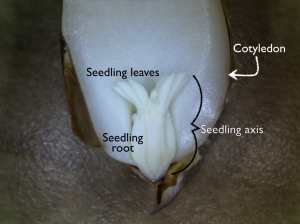
Katherine’s image of a germinating peanut seed (from her peanut post)
When the seed germinates the embryo will enzymatically break down or otherwise metabolize these compounds to fuel its initial growth (see Katherine’s description of bean seed anatomy, germination, and growth here and here). This copious amount of reserve material is why many legume seeds, including many that we use for food, are on the large side (McKey 1994). The 18-cm-long (inedible) seed of tropical legume tree Mora oleifera is the largest eudicot (large group of plants including legumes) seed on the planet (McKey 1994; I mentioned this previously in passing in my post on monocots and seed size).
The legume plant also uses that in-house nitrogen to make a lovely variety of extremely toxic nitrogen-rich alkaloid and lectin defense compounds that suffuse legume tissues along with a suite of other defense chemicals. These poisons are probably the main reason why humans do not use upwards of 99% of legume species for food. The largest single genus of plants on the planet, Astragalus, with over 3000 species, is in the Fabaceae (Frodin 2004). Only the root and resin, respectively from two Astragalus species (A. propinquus and A. brachycalyx), as far as I can tell, are used in any great quantity as people food, and both of those are considered more of a medicinal foodstuff or binder, rather than a main dish. The rest of the Astragalus species and several other legume genera are called “locoweeds” because of the neurological damage caused by their alkaloids. When they occur as weeds in pasture or as natural components of range ecosystems, locoweeds can and often do destroy livestock.
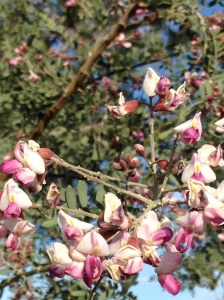
Desert ironwood (Olneya tesota), a beautiful but inedible legume tree from the Sonoran Desert, showing the most common legume banner-and-keel papilionaceous flower type
Reducing the toxicity of legumes has undoubtedly been a focus of legume domestication, especially of those species used as fresh vegetables. The toxic alkaloids can be neutralized by soaking and cooking in the legumes that people regularly consume. Even if considered to be technically somewhat edible by some crazy or desperate people, though, there are several legume species that should only be at most occasionally consumed in small quantities because of the long-term deleterious or immediately nauseating effects of these alkaloids (See essays on neurological damage called lathyrism caused by improper or excessive consumption of wild legume species in the genus Lathyrus by Hank Shaw and Green Deane and in Amy Stewart’s book Wicked Plants). I personally think it is unwise to eat the raw seeds or pods of any wild legumes, but the edible tubers of some of them are very cool and appear to be a lot less toxic than the leaves or reproductive structures).
As Katherine described in her black-eyed pea post, the carbohydrate raffinose in pulses probably isn’t a defense chemical, per se, probably serving a storage role in the seed, but it is what induces flatulence after people eat beans. Unless, that is, you consume Beano before your meal, which contains the enzyme necessary to break down raffinose. People do not make this enzyme, but our gut bacteria that help us digest our food do. When the bacteria tackle raffinose, they produce gas.
Legumes, by the way, are far from the only plants that make toxic alkaloids. Plant-derived alkaloids include some of the most famous and infamous recreational and medical drugs and poisons in humanity’s pharmacopeia, including caffeine, cocaine, and the wide variety of poisons in the nightshade plant family. Non-legumes, however, without that in-house nitrogen supply, can only make alkaloid defenses with nitrogen from the soil, after they’ve satisfied the nitrogen requirement for basic growth, maintenance and reproduction. That’s why the caffeine content of maté and coffee has been shown to vary strongly from farm to farm in concert with soil fertility, as I mentioned in my post on the botany of caffeine.
Thinking phylogenetically: Legumes in an evolutionary context

hyacinth bean (Lablab purpureus), a papilionoid legume
Before the invention of industrial means of chemically fixing nitrogen to produce artificial nitrogen fertilizer, the only way new nitrogen could enter ecosystems was through nitrogen-fixing microorganisms, either free-living in the soil or on the surface of plants, or in root symbioses with nitrogen-fixer plants. Aside from the legumes, some of which do not fix, only a few plant species form nitrogen fixation symbioses with microorganisms. All these other “nitrogen fixers” plant species form symbioses with Frankia actinomycetes that perform the nitrogen fixation, not Rhizobium bacteria as in legumes, and all are found within a large clade within the rosids (a group of plants all evolutionarily derived from a single common ancestor from within the large group of flowering plants named the rosids; Werner et al. 2014).
I mention this bit of evolutionary history not only because its discovery is a triumph of modern ecology. Legumes and other nitrogen fixers are evolutionarily unique. To me this puts in sharp relief how crucial these plants are for supporting human food security. Phylogenetic context (evolutionary relationships among species) in general helps us to better understand the similarities and differences in our food plants, their origins, and why they look, taste, and grow the way they do. For scientists trying to produce better agricultural varieties, phylogenetic context and other genetic and genomic information is essential. And in the case of an enormous plant family like the Fabaceae, the phylogeny is a big, tangled hot mess and is therefore a lot of fun to look at. I’ll do my best to show us where in the legume phylogeny our food comes from.
Legume Phylogenetics: Where are food plants come from in the legume family tree

fossil legume pod, Smithsonian Museum of Natural History, Washington, D. C.
The phylogeny of the legume family is still under construction. Inferring clades (groups of related species arising from a single common ancestor; monophyletic) within the family is complicated by the large number, broad geographic distribution, and genomic complexity of legume species. Before the modern age of using DNA data to infer evolutionary history, the legumes had been split into three major subfamilies: Caesalpinioideae, Mimosoideae, and Faboideae (formerly Papilionoideae). Much recent work, however, has demonstrated that the Faboideae and Mimosoideae arose from within what had previously been called part of the Caesalpinoideae (Legume Phylogeny Working Group 2013), meaning that the old Caesalpinoideae is paraphyletic (includes species from different clades) and therefore not especially useful for classification. Legume systematic biologists are actively replacing the old classification with new names of monophyletic groups within the Fabaceae (LPWG 2013).

red Chinese yardlong bean (Vigna unguiculata) plant
Most legume food plants are papilionoid legumes in the Faboideae. The most widely grown pulses are in four named clades: (1) Phaseoloids (Glycine or soy, beans in Phaseolus, Cajanus and Vigna); (2) Galegoids (lentils in Lens, alfalfa in Medicago, beans and peas in Pisum, Lathyrus, Vicia); (3) Genistoids (Lupinus); and (4) Dalbergoids (peanuts in Arachis)(Lewis et al. 2005, Smykal 2015). Phaseoloids are mostly pan-tropical, whereas galegoids are mostly in the temperate world. The Mimosoideae and Caesalpinoideae are mostly woody trees and shrubs. All major clades, however, include all multiple plant growth forms and may have broad geographical distribution.
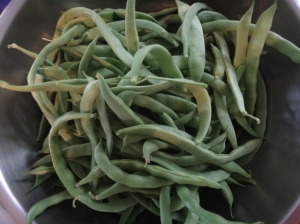 My list of edible legume species includes Latin and common names, structures consumed, growth form, taxonomic information, and geographic origin. You can use it to pair up common and Latin names in the Fabaceae phylogenies (Figures 1-3) below. Note, however, that this table only includes a few of the many thousands of variety names for these species. For example, you won’t see separate entries or even an extended list for the numerous varieties of common bean (Phaseolus vulgaris) available from your local grocery or seed catalog. I compiled my list of edible species from a few sources, listed in the References section, as well as personal knowledge. I’d like this list to eventually be exhaustive, but I doubt it is yet. If you think I’ve missed something or got something wrong, please let me know!
My list of edible legume species includes Latin and common names, structures consumed, growth form, taxonomic information, and geographic origin. You can use it to pair up common and Latin names in the Fabaceae phylogenies (Figures 1-3) below. Note, however, that this table only includes a few of the many thousands of variety names for these species. For example, you won’t see separate entries or even an extended list for the numerous varieties of common bean (Phaseolus vulgaris) available from your local grocery or seed catalog. I compiled my list of edible species from a few sources, listed in the References section, as well as personal knowledge. I’d like this list to eventually be exhaustive, but I doubt it is yet. If you think I’ve missed something or got something wrong, please let me know!
Below I’ve depicted the phylogenetic placement of our legume food plants (from my list) within the Fabaceae in three figures, one for the entire family with the Faboideae collapsed to a single branch, another for the Faboideae with a large group of Phaseoloids collapsed to a single branch, and a third for that large group of Phaseoloids. This was actually difficult to figure out, because the Fabaceae phylogeny is in such flux, and the more modern updates don’t include all of the edible species. So, really, this is my best current working guess. In my opinion, future legume systematic efforts, at least within the Faboideae, should make a point to include nutritionally and economically important species. In the phylogenies depicted in Figures 1-3, edible species common names are shown. For Latin names and species information, please see my table of edible legumes. Data for the phylogenies are from papers listed in the References section. If you need a refresher on reading phylogenetic trees, see our primer.
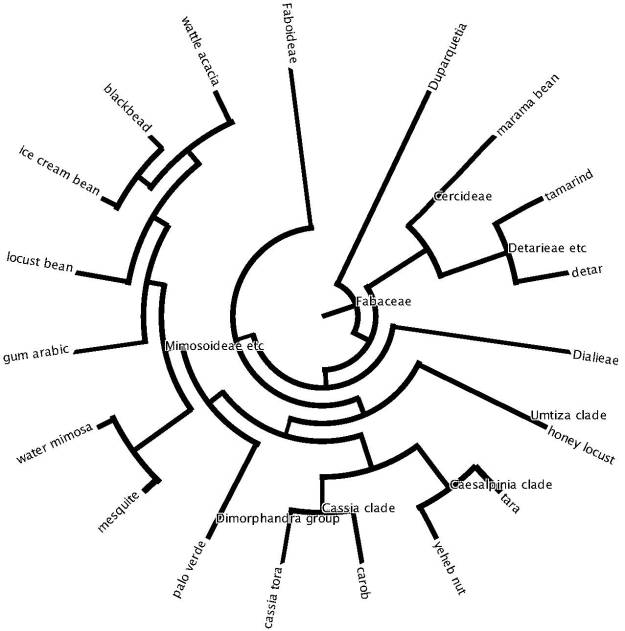
Figure 1: Phylogeny of the legume family (Fabaceae) showing position and relationships among edible legume species outside of the subfamily Faboideae/Papilionoideae, which is collapsed to a single branch (see Figures 2 and 3 for Faboideae phylogenies).

Figure 2. Phylogeny of Fabaceae subfamily Faboideae, with the exception of the large number of species in the Phaseoloid legume group collapsed here into a single branch called “Phaseoleae-ish” (see figure 3 for phylogeny of these taxa). Position of Faboideae within Fabaceae shown in Figure 1. Some major clades and positions and relationships among edible species are shown.
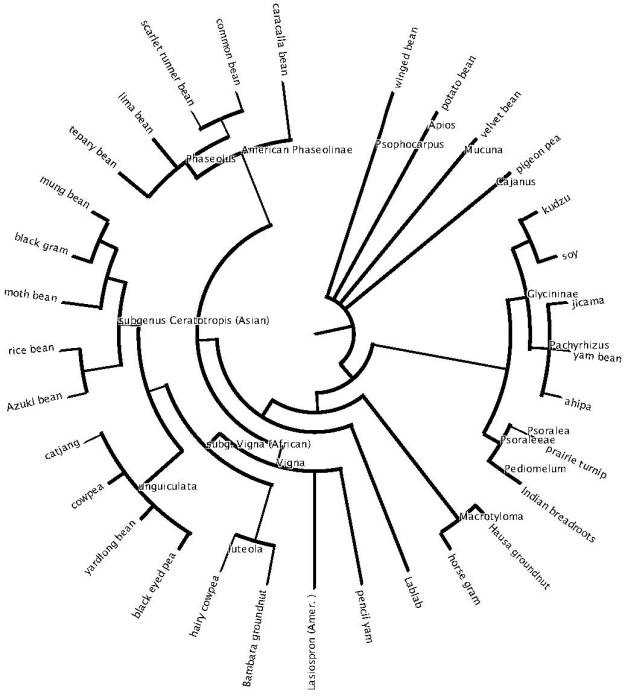
Figure 3. Phylogeny of a large clade of Phaseoloid legumes, the position of which is shown within the Faboideae in Figure 2 as “Phaseoleae-ish,” because many of these have variously been placed in a tribe Phaseoleae . The phylogenetic relationships among these species is in such a state of flux, it is difficult to ascertain the accurate phylogenetic positions of phaseolioid legumes at this time.
Whirled Peas

Fresh black-eyed peas, on the left and shelled in bowl on the right, with red Chinese long beans in the middle. Two varieties of cow pea (Vigna unguiculata) from our garden three years ago.
It’s no wonder the diverse and cosmopolitan legumes are ubiquitous in myriad winter holiday and traditions or celebrations. Even if the legumes are not the star of the show, they are present, integral. A few weeks ago we had a tamale-making party, a Mexican Christmas tradition. No beans went into the fillings, but everyone ate black beans alongside their tamales, and the coleslaw was dressed with a chickpea miso vinaigrette. Santa brought me a bottle of The Botanist gin, which has the best bottle: the Latin names of the 22 botanical ingredients are etched in raised glass. It includes two clover species (red clover, Trifolium pratense, and white clover, T. repens). We just bought our black-eyed peas to make traditional Hoppin’ John on New Year’s Day. But, mostly, around our house, we’ve been sending out wishes for Whirled Peas. My five-year-old has recently learned to pair her love of frozen green peas with a play on words. The lunchtime blessing in her classroom concludes with: “And may there be peace on Earth and in our hearts.” One recent afternoon I pointed out to her that “whirled” sounds a lot like “world,” and “peas” sounds a lot like “peace.” So she had some whirled peas, and here’s hoping that we all do too. May your 2017 be full of legumes and peace.
References
Cardoso, D., L. P. de Queiroz, R. T. Pennington, H. D. de Lima, E. Fonty, M. R. Wojciechowski, and M. Lavin. 2012. Revisiting the phylogeny of papilionoid legumes: New insights from comprehensively sampled early-branching lineages. American Journal of Botany 99:1991-2013.
Christenhusz, M. J. M., and J. W. Byng. 2016. The number of known plant species in the world and its annual increase. Phytotaxa 261: 201-217.
Delgado-Salinas, A., M. Thulin, R. Pasquet, N. Weeden, and M. Lavin. 2011. Vigna (Leguminosae) sensu lato: The names and identities of the American segregate genera. American Journal of Botany 98:1694-1715.
Frodin, D. G. 2004. History and concepts of big plant genera. Taxon 53:753-774.
Gepts, P. 1998. Origin and evolution of common bean: past events and recent trends. HortScience 33:1124-1130.
Hanson, T. 2015 The triumph of seeds: How grains, nuts, kernels, pulses, and pips conquered the plant kingdom and shaped human history. Basic Books.
Heine, J. 2016. Pulses: a multi-faceted crop. Food outlook: biannual report on global food markets. Food and Agriculture Organization of the United Nations.
LPWG: Legume Phylogeny Working Group. 2013. Legume phylogeny and classification in the 21st century: progress, prospects and lessons for other species-rich clades. Taxon 62:217-248.
Lewis, G., B. Schrire, B. Mackinder, and M. Lock. 2005. Legumes of the World. Royal Botanic Gardens, Kew. UK.
McKey, D. 1994. Legumes and nitrogen: the evolutionary ecology of a nitrogen-demanding lifestyle. In: Advances in Legume Systematics 5: The nitrogen factor. Edited by Sprent, J. I., and D. McKey. Royal Botanic Gardens, Kew. Pages 211-228.
Pratap, A., and J. Kumar. 2011. Biology and breeding of food legumes. CABI.
Smykal, P., C. J. Coyne, M. J. Ambrose, et al. 2015. Legume crop phylogeny and genetic diversity for science and breeding. Critical Reviews in Plant Science 34:43-104.
Stevens, P. F. 2016. Missouri Botanical Garden’s Angiosperm Phylogeny Website. Version 12, July 2012 (and more or less continuously updated since).
Stewart, Amy. 2009. Wicked plants: The weed that killed Lincoln’s mother and other botanical atrocities. Algonquin Books.
Vaughan, J. G., and C. A. Geissler. 2009. The New Oxford Book of Food Plants. Oxford University Press.
Vitale, A., and R. Bollini. 1995. Legume storage proteins. In: Seed Development and Germination. Edited by J. Kigel. CRC Press. Pages 73-102.
Werner, G. D. A., W. K. Cornwell, J. I. Sprent, J. Kattge, and E. T. Kiers. 2014. A single evolutionary innovation drives the deep evolution of symbiotic N2-fixation in angiosperms. Nature Communications 5: 4087.
Wojciechowski, M. F., M. Lavin, and M. J. Sanderson. 2004. A phylogeny of legumes (Leguminosae) based on analysis of the plastid matK gene resolves many well-supported subclades within the family. American Journal of Botany 91:1846-1862.
Wojciechowski, M. F., M. J. Sanderson, K. P. Steele, and A. Liston. 2000. Molecular phylogeny of the “temperate herbaceous tribes” of Papilionoid legumes: A supertree approach. In: P. S. Herendeen and A. Bruneau (editors). Advances in Legume Systematics 9. Pages 277-289. Royal Botanic Gardens, Kew. UK.

What about 2017???? Xxxcvh
On Dec 28, 2016 4:19 AM, “The Botanist in the Kitchen” wrote:
> Jeanne L. D. Osnas posted: “The United Nations declared 2016 the > International Year of Pulses. What’s a pulse? It’s the dry mature seed of a > large number of species in the legume family (Fabaceae): various beans, > peas, soybean, chickpeas, lentils, peanuts and other groundnuts. 2016 ” >
LikeLike
I don’t know what it is yet. Such anticipation!
LikeLike
it looks like it will be the International Year of Sustainable Development. Instead of focusing on one plant group, we may bring you news of traditional less-known sustainable crops. Stay tuned!
LikeLike
Very interesting. We have been including more legumes in our daily meals.
On Wed, Dec 28, 2016 at 1:18 AM, The Botanist in the Kitchen wrote:
> Jeanne L. D. Osnas posted: “The United Nations declared 2016 the > International Year of Pulses. What’s a pulse? It’s the dry mature seed of a > large number of species in the legume family (Fabaceae): various beans, > peas, soybean, chickpeas, lentils, peanuts and other groundnuts. 2016 ” >
LikeLike
awesome!
LikeLike
It’s fun that peanuts are among the Dalbergoids. Sounds like “goober” to me – coincidence??
LikeLike
You could recommend “goober” as a nickname for the Dalbergoids. The goober clade.
LikeLike
Incredibly attractive and useful post! Thank you. More than once as I skimmed your images of lintels, I remembered how many different types of chaunches are added to lintels in order to prepare dahl (soup). Each chaunch has an amazing variety of botanicals put under intense heat to release their aromas and tastes–have you ever done a post on those?
LikeLike
Thank you for the kind comment. I’ve never heard of a chaunch. Sounds interesting!
LikeLiked by 1 person
Chaunch, I have only heard this word in conversations. In the bottom of an empty pan over heat, is added a bit of purified butter (ghee) then the selected spices/herbs to be heated to release flavours, aromas. Then the lentils and water are added. And the heat reduced. Sub-continent Indian cooking. That is all I can say. I don’t cook. But I hear kitchen conversations. 🙂
LikeLike
Ah, thanks. Katherine has an excellent essay on some (not all) of the spices commonly used in Indian cooking, as well as a description of how pepper and chilis produce a heat sensation in our mouths. I wrote about terpenes that flavor many of the spices, as well.
LikeLiked by 1 person
Nice article. Don’t forget : Before the invention of industrial means of chemically fixing nitrogen to produce artificial nitrogen fertilizer….
There was guano, a nice story in itself
LikeLike
Indeed. But, how did the nitrogen get into the guano? The ultimate source was biological nitrogen fixation by microbes, in symbiosis with plants or other organisms or not.
LikeLike
This was a great read, especially for a legume-lover! All of it incredibly detailed and cited, but I especially enjoyed the section about n-fixation. And the work on phylogenetics that you’ve done, outstanding. Looking forward to checking out your list of edible legumes.
LikeLike
Thank you for this feedback!
LikeLike